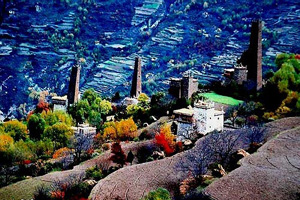

CUT001-3: Amdo and Kham
Introduction: Amdo is one of the three traditional states of Tibet, the other two being Ü-Tsang and Kham; it is also the birth place of Tenzin Gyatso, the 14th Dalai Lama. Amdo encompasses a large area from the Machu River (Yellow River) to the Drichu river (Yangtze River). While culturally and ethnically a Tibetan area, Amdo has been administered by a series of local rulers in recent centuries. After the Chinese invasion of Tibet, Amdo was divided and incorporated into the Chinese provices of Gansu, Sichuan and Qinghai. While identically named, the sparsely-populated Amdo County in the Tibet Autonomous Region (TAR) is not part of the Amdo cultural province. It was directly administered by the Dalai Lama from Lhasa and is today a part of the Changthang region administered by Nagqu in the northern part of the TAR.
Amdo and Kham This route is designed to have a lot of flexibility in its pacing. As much of the accommodation in this part of the world is fairly rough and/or characterless, the default option on this trip will be to find scenic, convenient spots to set up camp, which is often more comfortable - certainly more rewarding - and frees us from having to “make the next town”.
Day1: Arrive in Chengdu Arrive in Chengdu, the capital city of Sichuan Province, habitat of giant pandas and city of cotton-rose hibiscus. Transfer to hotel.
Day2: Chengdu – Wolong – Danba Set out from Chengdu to Danba, visit Wolong Giant Panda Breeding Center. Continue driver for Danba county, Danba county lies on the southern edge of the Qinghai-Tibet Plateau. Human activity in Danba dates back more than 5000 years. Overnight in Danba.
Day3: Danba – Bamei In the morning, visit the Suopo Defense Tower, this tower made of stone and very solid, then visit Jiaju village, Jiaju Tibetan folk house has very special feature. Arrive in Bamei in the end of the afternoon. Overnithe in gueshouse.
Day4: Bamei – Garze Drive for Garze. It is a county in northern Kham, with a low verdant agricultural valley surrounded by high rocky mountains. Visit the Garze Monastery, it was originally constructed by the Qosot Mongols circa 1642.
Day5: Garze – Manigango – Derge In the morning, visit Yilhun Lhatso (Xinluhai Lake or Yulong Lake), located beside the Maingange town about 11km. Then drive 210km to Derge, stay two nights in Derge.
Day6: Derge – the Derge Printing House Visit the Derge Printing House and Gengqing Monastery, is the treasury of Tibetan culture and arts, founded in 1729.
Day7: Derge – Pelyul Drive along the Golden Sand River the upper reaches of Yangtze River to Pelyul. Upo arrival visit Pelyul Monastery of Nyingma Sect. Night in guesthouse.
Day8: Pelyul – Garze – Luhuo Leave for Ganze via Haizi Shan. On the way appreciate the snow mountains and vast grasslands. In the afternoon reach Luhuo, which was called ‘Huoer’means Mongolians and Zhanggu on the mountain rock. Night in guesthouse.
Day9: Luhuo – Rangtang After breakfast, head of Rangtang. After crossing the high Laowozeshan Mountain, visit Sirin Kar Monastery (Zeng Ke Si) of the Karma-Kagyuepa order. In Tibetan Rangtang, it means the Treasure God’s Flat Land. Overnight in guesthouse.
Day10: Rangtang – Aba In the morning, drive on gravel road to Aba. On the way visit Rangtang Temple the biggest monastery of the Jonang Sect of Tibetan Buddhism. Belonging to Dadanpingchuo Monastery.
Day11: Aba In the morning visit Gelden Monastery of Gelug Sect. Originally built in 1870. it has become the biggest monasteries in Kham-Amdo. After that visit Nangyi Monastery, located at a hillside to the northeast of the Aba county. Nangyi Monastery is one of the biggest Bon monastery in China and has a history of about 900 years after it was built in 1107.
Day12: Aba – Tangke – Ruo’ergai After breakfast drive 230km on gravel road to Ruo’ergai county (3500 meters). As arriving at Tangke 68 kilometers from Ruo’ergai, go sightseeing on the Nine Bends of Yellow River and Suokezang, a small temple of Gelug Sect standing by the river. Ruo’ergai is called as the “Oasis on the highland”.
Day13: Ruo’ergai – Miyaluo – Gu’ergou Drive to via Moyaluo to Gu’erguo, where you can enjoy bath bath in the hotsproing.
Day14: Gu’erguo – Langmu town Drive 200km from Gu’erguo to Langmu village, en route drop a visit to Taoping village of the Qiang ethnic group and Ganbao village (risidential house of Tibetans). Arrive in Langmu town in the afternoon, free in the afternoon.
Day15: Langmu Monastery Visit the Langmu Monastery, the Langmu Monastery is headed by the Living Buddha Langmu Saici, Lozang Nanjie Longren Sanggai, who is vice-chairman of the standing committee of the prefectural people congress of Gannan.
Day16: Langmu – Xiahe – Labrang Transfert to Xiahe county, about 4 hours, have a lunch in Xiahe. Then continue to Labrang, one kilomeer west of Xiahe county, and visit the Labrang Monastery.
Day17: Labrang – Tongren – Longwu monastery Transfer in the morning to Tongren county, antonomous county of Tibetan national minority. After lunch, walk to the Longwu monastery, the biggest temple of the Gelug Sect of Lamaism in the south of Qinghai built in 1301.
Day18: Tongren – Xining – Kumbum monastery Leave Tongren for Xining, the capital city of Qinghai Province, 4 hours arrive in Xining, take a lunch. Then dirve 25km to Kumbum monastery and visit this monastery. Overnight in Xining.
Day19: Fly to Chengdu – Departure
|
